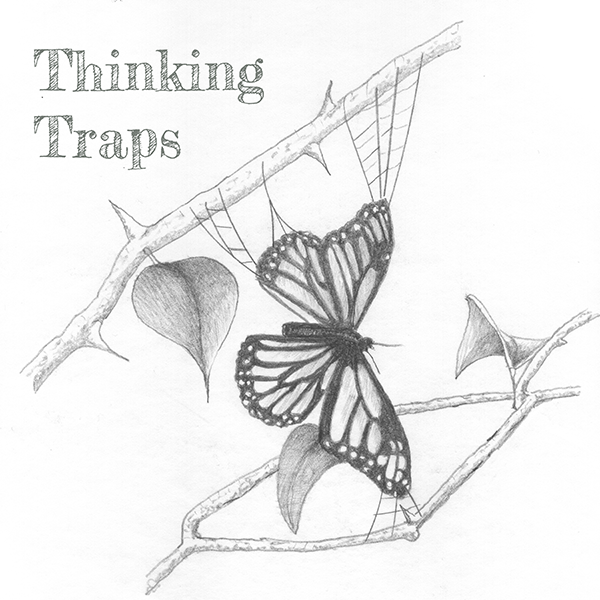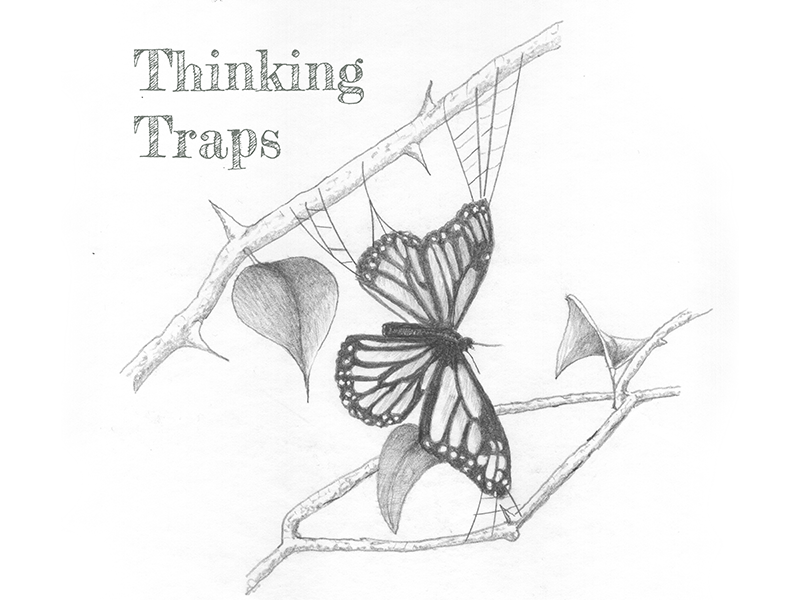Have you ever seen a butterfly caught in a spider’s web?
They fly right into the invisible threads, and before they know it, they’re stuck—trapped in the sticky strands, rapidly fluttering their wings.
It’s just as easy for us to get caught in thinking traps. Thinking traps are cognitive distortions, set by our own mind, alter how we perceive reality.
Like a spiderweb, thinking traps are difficult to see, and we often don’t realize the trap was there until we’re stuck. If we can learn to recognize the most common thinking traps, they will be more immediately recognizable—and therefore avoidable.
Here are 10 thinking traps you should look out for:
1. Catastrophizing: Catastrophizing is immediately jumping to the worst possible conclusion when something bad happens. It’s when something goes wrong, and no matter how small, we think it will be a total disaster. For example, maybe you take a test and don’t feel it went as well as it could have, but think to yourself, “I definitely failed that test. I probably will fail the course now, and have to drop out of the program. I’ll never be successful.” It magnifies the potential outcomes and exaggerates their importance.
2. Negative filtering: Negative filtering is like the opposite of rose-colored glasses. Instead of seeing things positively, we only see the negative and discount the real, positive things going on in our life. For example, you receive some constructive feedback at work. Your manager gave you a lot of kudos too, but you dwell on the one negative and don’t take all of the positive comments into account. It’s not that the constructive feedback isn’t valid, but it also shouldn’t outweigh all of the good things that were also said.
3. Black and white thinking: Black and white thinking is looking at the world with an all-or-nothing lens. Everything’s perfect or ruined, amazing or terrible—there’s no middle ground. For example, the barista messes up your coffee order, and you declare it the worst latte you’ve ever had and your day ruined. Thinking in an either/or dichotomy is unrealistic. Getting comfortable with shades of gray is more balanced approach.
4. Mind reading: Believing we know the thoughts and motives of other people is called mind reading. We imagine them judging or hating us, even if that’s not the case at all. For example, if a friend misses your party, you might assume they’re mad at you and purposefully missed it. In reality, their absence was likely unrelated to how they feel about you. We can’t assume the thoughts or feelings of others.
5. Fortune telling: When we predict future events as though they were certain, that’s fortune telling. It takes mind reading a step further, from assumptions to predictions. For example, saying, “nothing will ever get better.” is fortune telling. Fortune telling can lead to self-fulfilling prophecies because our actions based on our beliefs.
6. Labeling: Labeling is giving yourself or others a negative label, or attributing a negative event to the person. These are typically “I” or “you” statements. For example, if you failed an exam and say “I’m a failure,” instead of “I failed that test.” Focus on attributing effects to the cause alone, rather than to yourself personally.
7. Emotional reasoning: Emotional reasoning is mistaking our feelings for actual facts. Maybe you’re feeling stupid one afternoon, and mistake that feeling for a fact, and assume that you ARE stupid. In reality, you’re perfectly intelligent. Our feelings, no matter how strong they may be, aren’t facts.
8. Pressurized or extreme words: Words like always, never, can’t, and should are examples of pressurized or extreme words. They’re rarely true and often make us feel worse. For example, if you make a mistake, and you say “I always do that. I can’t do anything right. I should never be trusted.” A healthier alternative would be to own up to the mistake, but recognize that it’s not a hallmark of your behavior.
9. Personalization and blame: Personalization and blame is when we take full responsibility for events outside of our control. Say you take your family on vacation, and it ends up raining every single day. You tell your family that you’re sorry you ruined their vacation and you should have known to pick a different time. You can’t control the weather, so it’s simply not accurate.
10. Overgeneralization: When we think, “If it happened once, it will always happen.” Let’s say you had one bad date, and now you think all dates will be terrible, you’re a terrible dater, and you’ll end up alone—none of which are true. Overgeneralization is expecting a negative event into a negative pattern.
Butterflies are usually not stuck in spiderwebs for long: Their wings have scales that allow them to detach from the web and more easily escape. Further, the spiders themselves don’t want them in the web. If the butterfly is stuck for a long period of time, they can damage the web’s construction.
Just like the butterfly caught in the web, you have the power to escape, and being stuck in any trap for too long can be damaging to your mental health. Cognitive behavioral therapy is based on the foundational principle that our thoughts affect our feelings, and our feelings affect our behaviors. Simply put, the way we think directly impacts the way we feel.
By being aware of these thinking traps and changing the way we think, we can prevent cognitive distortions, change our emotions, and break free of the vicious cycle.

By Dr. Monika Roots
Chief Medical Officer, Sanvello
Dr. Roots practiced as a child, adolescent, and adult psychiatrist. She was also a Clinical Adjunct Assistant Professor at University of Wisconsin-Madison and was most recently the Vice President of Health Services and Behavioral Health for Teladoc Health. In 2016, Teladoc Health acquired her business, CogCubed, a behavioral health analytics company. Dr. Roots earned her MD from University of Sint Eustatius School of Medicine and completed psychiatry residency and fellowship in child/adolescent psychiatry at the University of Minnesota.

